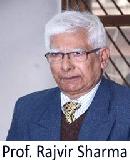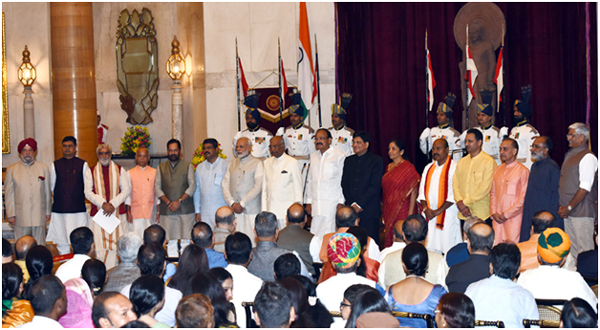 Prime Minister Narendra Modi revamped his council of ministers on 3rd September 2017, may be the last one before he seeks peoples’ mandate again in 2019. What might have been the considerations weighing with him in making the choices he has made. The first and the foremost is his approach to governance that is productive, innovative, transformative and pro poor. This is what he has been emphasizing with the bureaucracy as well as the political leaders in his party and legislative wings.
Prime Minister Narendra Modi revamped his council of ministers on 3rd September 2017, may be the last one before he seeks peoples’ mandate again in 2019. What might have been the considerations weighing with him in making the choices he has made. The first and the foremost is his approach to governance that is productive, innovative, transformative and pro poor. This is what he has been emphasizing with the bureaucracy as well as the political leaders in his party and legislative wings.
He is aware that now on the government will have to roll out results of the programmes and policies framed by the government to ensure that hopes and aspirations of the youth, the poor, the kisan (farmer), the exploited and of the deprived raised by him at the time of elections and thereafter remain floating and their support to the BJP and the government remain undented. This is the reason that he is retiring the lazy, the inefficient and the non-performers from both the administration as well as the council of ministers.
The second most significant factor influencing his decision to reshuffle his cabinet is to spread his reach and appeal to the minorities in a more visible form. The inclusion of Hardeep Singh Puri, KJ Alphonse and upgrading the portfolio of Muqhtar Abbas Naqvi is a pointer in that direction. Furthermore, he has tried to provide an edge to his commitment to ameliorating the conditions of Gaon, Garib and Kisan by including leaders like Virendra Kumar, Gajendra Shekhawat and Ashwini Chaube, who are known for their grass root level work.

Thirdly, he thinks that governance is neither politics nor profession alone. It has to be a mix of both. So he has inducted leaders having political and professional acumen. This is evidenced by the fact that all of the professionals among the newly included ministers have been given a position of Minister of state implying thereby that politicians (the existing cabinet ministers) and the administrative experts shall pool their energies together to bring about intended changes in all the arenas of Indian nation. This, in the Prime Minister’s view, shall bring a new sense of purpose and efficiency and proficiency in the government.
His government should not only perform but also be perceived to be performing because politics is mostly a perceptional game. This is all the more essential element in the context of efforts by all his opponents in unison to paint him and his government as a failure in keeping his promises made to the various sections of the electorate.
Fourthly, the PM wanted to make it clear that every minister has to defend his/her wicket without any external support that is with the help of his own capability, competence and performance. The head of the government has made it amply clear that politics of maneuvering or manipulation is not valid for retention of a person in the cabinet. He has conveyed this time also that he is an active Prime Minister intolerant of taking persons on face value. In other words he is continuously watchful of his colleagues and evaluating and assessing them regularly on the scales of energy, commitment to work, efficiency, effectively established through utilising their expertise and experience to achieve the goals of progress and change. Reshuffle can also be an exercise to accommodate the needs and requirement of the party and the government as a chariot cannot be pulled with one wheel alone. So some of the ministers relieved from their responsibility can be made available for organizational work as the strength of the party and the image of the PM and of the government go together to win the elections.
The fifth message flowing from the exercise undertaken by the PM is that though it is a NDA government, but not of the times of AB Vajpayee. While the PM, therefore, is open to adjust and accommodate the genuine needs and compulsions of the allies, he cannot be subjected to arm twisting or pressure politics. That seems to be the reason why all the vacancies have not been filled by him leaving enough time and space for the allies to discuss and decide to the satisfaction of both. That he does not act under pressure or threats is also the message to his own colleagues in the parliament and in the party. He goes solely by the principle of merit in each case. The party and the prime minister are on the same page in this matter.
PM Modi is conscious of the fact that coordination and cooperation between the party and the government is a precondition for electoral and governance success. Therefore he takes inputs from the party before executing the change in the council of ministers. The PM has given due place to the values of transparency, honesty and openness in the government, accountability of the ministers and administrators has been at the centre of his focus as well. The assessment on the scale of P (positive) and N (negative) report is one step in that direction. So despite being the most popular and powerful prime minister of the time, he appreciates the limitations of power and democratic politics.
All said and done, the utility of the whole act will depend on the extent to which the new and reorganized team would be able to translate the dream of new India into a reality. This would largely require what the Prime Minister describes as passionate involvement of the ministers in charge to be vigilant over the work done and work remains to be done almost on a daily basis.
For this to happen, it is necessary for them to value fearless expert advice of the bureaucrats on the one side and ruthlessly discourage inertia in them. The ministers have to be in the activist’s role to prove that it is a government with a difference to win the trust of the people again in 2019. The economic reforms and pro poor delivery of the schemes and programmes must have to be effectuated simultaneously. Growth with social justice is the imperative of new India, an India free from Bhaya (fear), Bhookh (hunger) and Bhrashtachar (corruption).
(The writer is Senior consultant, School of Social Sciences, IGNOU, New Delhi)
